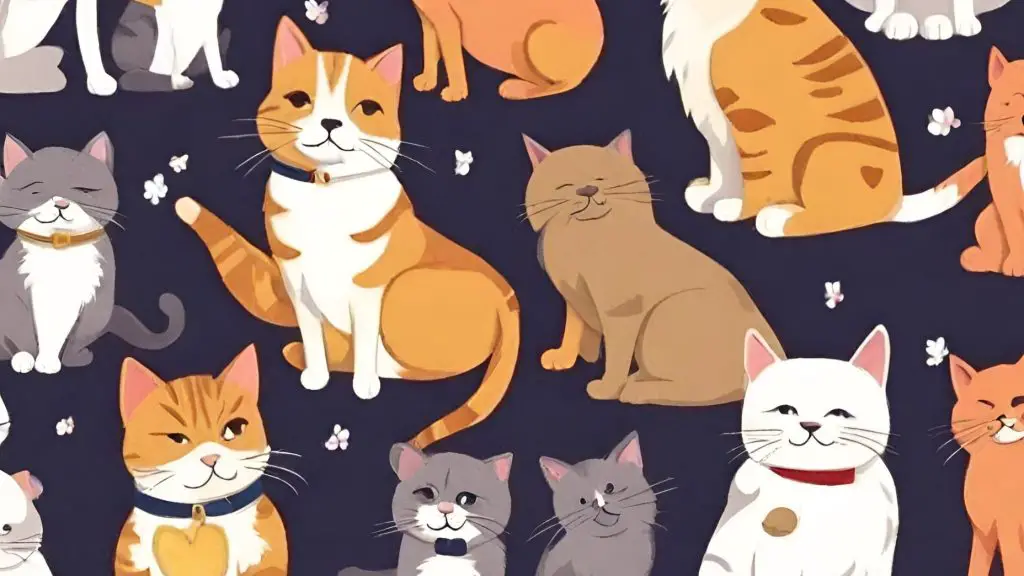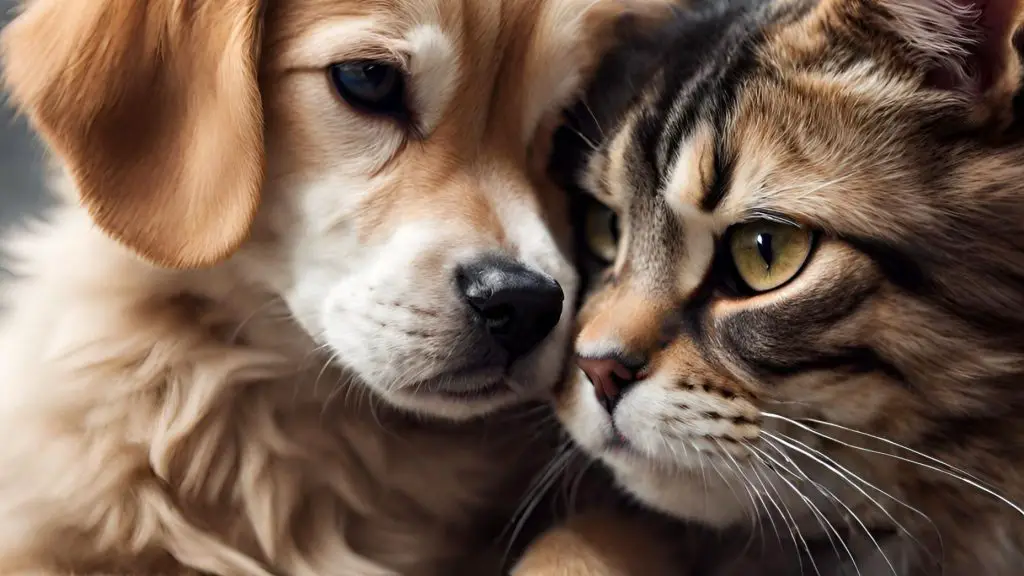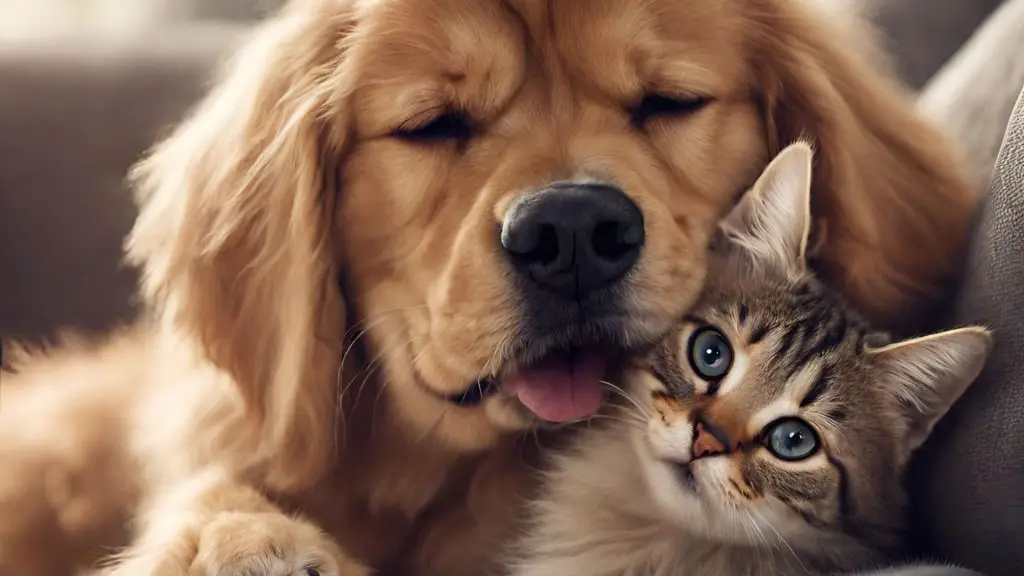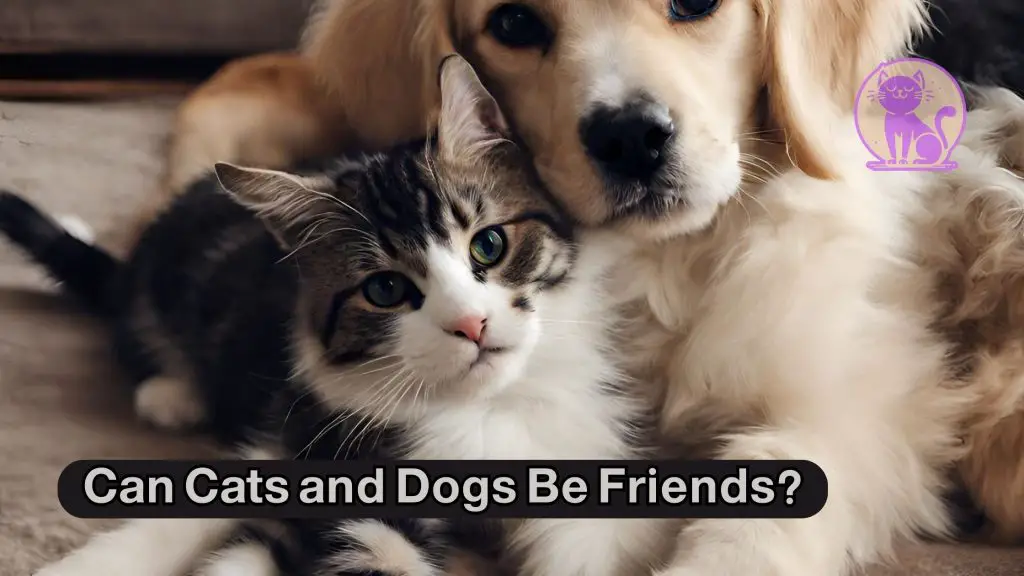The debate has raged for ages, fueled by cartoons and anecdotal evidence alike: can cats and dogs be friends? Dispelling the myth of the archetypal enemies, this exploration delves into the heartwarming reality that building relationships between cats and dogs is not only possible but also enriching for both pets and their owners. Through understanding, patience, and the right approach, the journey of fostering cat and dog friendship can begin, transforming what many assume to be a natural rivalry into a bond of companionship.
The Age-Old Question: Can Cats and Dogs Be Friends?

For generations, pet lovers have pondered if the uneasy glances between Fluffy and Fido could transform into a warm companionship. It’s a tale as old as time, the narrative that cats and dogs are inherent adversaries. Yet, amidst the tangle of fur and paws, there lie genuine stories and scientific research that suggest a possibility for peace and friendship. When it comes to cat and dog bonding strategies, encouraging friendship in cats and dogs, and creating harmony between cats and dogs, the key elements orbit around understanding, patience, and the careful nurturing of their relationship.
From viral videos displaying feline-canine snuggles, to scholarly articles dissecting their behaviors, evidence points towards a spectrum of possible interactions. But what really goes into fostering a serene environment where whiskers and wags coexist in harmony? Below, we explore various strategies that pet owners can utilize to encourage a budding companionship between their four-legged friends.
- Introduce pets during their formative years to cultivate familiarity.
- Allocate dedicated spaces for individual solace as well as shared areas for mutual exploration.
- Incorporate positive reinforcement to reward peaceful interactions.
- Monitor body language to ensure both animals are comfortable during their encounters.
- Remain consistent in approach and allow the animals to dictate the pace of their relationship growth.
“While cats and dogs may not be natural bedfellows, with the right approach and a sprinkle of patience, they can certainly learn to share their bed.” – Anecdote from a seasoned veterinarian
A comparative table below highlights different bonding techniques and their potential impact on facilitating friendship between cats and dogs:
| Bonding Technique | Impact on Cats | Impact on Dogs | Potential for Friendship |
|---|---|---|---|
| Joint Play Sessions | Stimulates curiosity and exercise | Encourages controlled social behavior | High |
| Feeding in Close Proximity | Develops toleration of dogs during vulnerable activity | Teaches respect for feline space | Moderate |
| Desensitization to Each Other’s Scents | Builds recognition and reduces anxiety | Fosters familiarity and reduces prey drive | High |
| Shared Sleeping Areas | May increase trust through vulnerability | Can strengthen pack mentality to include the cat | Variable, depending on the individual temperaments |
In investigating the entwining paths of cats and dogs toward friendship, one must bear in mind the idiosyncrasies of each creature. Like any relationship worth pursuing, the journey of encouraging cats and dogs to bond is layered with setbacks and triumphs. However, it’s through continual effort and adherence to cat and dog bonding strategies that pet owners can lay the groundwork for a lasting friendship between their furry companions.
Understanding the Natural Instincts of Cats and Dogs

When introducing cats and dogs, it’s essential to appreciate the underlying natural behaviors that can shape their interactions. Recognizing these instincts not only aids in promoting positive interactions between cats and dogs but is also a stepping stone towards successful cat and dog bonding strategies.
The Hunter and the Hunted: Predatory Behaviors
Felines and canines possess inherent predatory instincts which, in a domestic setting, could be misinterpreted as aggression or play. Cats may view smaller dogs as prey, while dogs may see cats as potential targets, especially if they have a strong chase drive. Balancing these natural tendencies is key to ensuring peaceful cohabitation and mitigating stress-inducing encounters.
Communication Barriers: Body Language and Signals
Understanding the distinct communication styles of cats and dogs can avoid common miscommunications. Where a dog’s wagging tail may indicate excitement or happiness, a cat’s thrashing tail suggests irritation or anger. Educating oneself on these nuances empowers pet owners to facilitate better comprehension and more harmonious interactions between their pets.
Territorial Tendencies: Space and Resources
Both cats and dogs can exhibit territorial behavior, which may lead to conflicts in shared spaces. It’s vital to manage their environment judiciously, providing sufficient resources, such as food bowls and resting areas, to prevent competition and promote a sense of security for both animals.
| Predatory Behavior | Communication | Territoriality |
|---|---|---|
| Understanding prey drive in dogs and predatory instincts in cats | Identifying body language cues unique to each species | Separate feeding stations to reduce conflict |
| Implementing play that satisfies these instincts in a controlled manner | Teaching pets to recognize and respect each other’s signals | Providing personal spaces for each pet to retreat and relax |
| Redirecting inappropriate chase behavior with toys and activities | Maintaining a calm demeanor to avoid overstimulation | Rotating which pet has access to common areas to ease tension |
Fostering Cat and Dog Friendships: Steps to Success
Many pet owners dream of a household where their cats and dogs coexist in harmony, perhaps even forging a close bond. To turn this dream into reality, there are several steps one can take to encourage friendship between cats and dogs. It’s not an overnight process, but with patience and the following strategies, you’re on your way to fostering a cat and dog friendship.
- Slow Introductions: Introduce pets slowly, allowing them time to become accustomed to each other’s scent and presence. This may take days or weeks, and it’s best done in controlled, short sessions.
- Supervised Interactions: Initially, all interactions between your cat and dog should be supervised. Look for signs of stress or aggression, and separate them if necessary. Positively reinforce any calm or curious behaviors.
- Creating a Safe Space: Ensure each pet has a safe, private space where they can retreat to if they feel overwhelmed. This is particularly important for cats who typically value their own territory.
Additionally, the environment you create for both your cat and dog can play a pivotal role in how well they get along. Below is a table that outlines the key elements to consider when setting up their living space.
| Element | Cat-Friendly Features | Dog-Friendly Features |
|---|---|---|
| Resting Areas | Elevated shelves, quiet nooks | Comfortable dog beds, space for movement |
| Feeding Stations | Separate areas from dogs, possibly elevated | Consistent location, away from the cat’s space |
| Play Zones | Toys that encourage pouncing and climbing | Interactive toys, room to run and fetch |
| Litter Boxes | Private, not easily accessible by the dog | Keep away from dog’s bed and feeding area |
Remember, each pet’s personality is different, and what works for one pair may not work for another. The key is to remain patient, observant, and consistent in your efforts to promote a peaceful coexistence between your cherished pets.
Introducing Cats and Dogs: Creating First Impressions

Integrating a cat and dog into the same household requires a nuanced approach, ensuring the first meeting between them sets a positive tone. By carefully introducing cats and dogs, pet owners can lay the groundwork for creating harmony and fostering a cat and dog friendship that lasts a lifetime.
Initial Meeting Strategies
When introducing your pets, take a gradual, patient approach. Begin with scent swapping, transferring each pet’s scent to the other using a cloth or brush. Allow your pets to explore these scents in their own spaces to become accustomed to each other’s presence without direct contact.
Managing the Environment
Creating a non-threatening environment is essential during initial interactions. Arrange a neutral room for the first face-to-face meeting, ensuring the space is escape-proof for your cat and has no corner traps. Remove any potential hazards and provide hiding places for your cat to retreat if needed. For your dog, a leash might be necessary for controlled introduction while still allowing a degree of free movement.
Reading Animal Behaviors During Introductions
- Look for signs of relaxation: A relaxed body posture in both animals, with a calm tail and ears in a natural position, indicates comfort.
- Watch for play signals: Gentle, playful behaviors such as the ‘play bow’ from dogs can be positive, but ensure cats don’t misunderstand these actions.
- Notice warning signs: Hissing, growling, or a stiff body posture are indications to separate the pets and try again later.
Being observant and responsive to these behaviors enables pet owners to adjust the setting or pace of introductions accordingly.
Tips for Cats and Dogs to Coexist Peacefully
Creating harmony between cats and dogs under the same roof often requires a deliberate and strategic approach. By embedding key cat and dog bonding strategies within the daily fabric of our pets’ lives, we can promote positive interactions that lead to a peaceful coexistence. Below are some crucial steps to aid in this endeavor:
- Establish Separate Resting Areas: Give each pet their safe zone where they can retreat and relax without being disturbed by the other.
- Promote Positive Interactions: Use treats and praises to reward calm and friendly behavior when your pets are in each other’s presence.
- Ensure Proper Introduction: Introducing your cat and dog in a controlled manner is key. Keep initial interactions short and sweet.
- Monitor Body Language: Being alert to signs of stress or aggression can prevent negative experiences from escalating.
- Provide Individual Attention: Spend quality time with each pet to foster a secure bond and prevent potential jealousy.
- Keep a Routine: Consistent schedules for feeding, play, and exercise can help minimize confusion and stress.
Moreover, sometimes visualizing the contrast in needs and behaviors can be a game-changer for understanding how to manage a multi-pet household. Consider the following table:
| Cat Needs | Dog Needs |
|---|---|
| High perches and private spaces | Room to roam and play |
| Stimulating toys that mimic prey | Interactive toys that promote exercise |
| Quiet time alone | Regular opportunities for socialization |
| Litter box in a low-traffic area | Consistent routine for bathroom breaks |
| Scratching posts to mark territory | Training sessions to establish boundaries |
By attentively catering to these distinct needs, you’ll be setting a foundation for your cat and dog to feel comfortable. This promotes an environment where bonding is more likely to flourish naturally. Remember, patience and understanding are the cornerstones of creating harmony between cats and dogs, laying the groundwork for a loving, albeit sometimes quirky, family dynamic.
Building Relationships Between Cats and Dogs: The Role of Owners

As architects of domestic harmony, pet owners carry a significant responsibility when it comes to building relationships between cats and dogs. The success of forming these interspecies friendships often hinges on the human element. Proper handling and consistent training are pillars in fostering cat and dog friendship, while the owner’s attitude often serves as the cornerstone for peaceful coexistence. Let’s delve into some key areas where pet owners can make a positive impact.
The process begins with understanding that every interaction you orchestrate is a building block towards a stronger foundation. From intentional playdates to structured feeding times, your role in guiding interactions is critical. But beyond these sessions, your day-to-day behavior sets an example. Pets are incredibly attuned to their owner’s feelings and responses. Hence, maintaining a calm and collected demeanor in the face of new or stressful situations can go a long way in reassuring your pets.
| Consideration | Impact on Cats | Impact on Dogs |
|---|---|---|
| Consistency in Training | Develops routine and trust | Establishes boundaries and obedience |
| Owner’s Attitude | Reflects in cat’s comfort levels and sociability | Influences dog’s confidence and interaction |
| Proper Handling | Increases confidence in social scenarios | Encourages gentleness and respect towards the cat |
Remember, the journey to fostering cat and dog friendships is often paved with patience. The occasional hiss or bark is not uncommon and doesn’t signify failure, but rather moments for learning and adaptation. By celebrating small victories and staying committed to tips for cats and dogs to coexist, pet owners can encourage a rapport that burgeons into a true friendship. Encourage each pet to express their personality, reinforce positive behaviors, and remember to enjoy the unique bond that is forming under your guidance.
- Observe your pets’ interactions and step in when necessary to prevent negative experiences.
- Allocate individual attention to prevent jealousy and to affirm each pet’s place in the family.
- Invest time in individual and joint training sessions to build mutual respect and understanding.
In conclusion, the synergy of your efforts as an owner doesn’t merely coalesce in a truce between your furry friends; it has the potential to bloom into a testament of interspecies companionship. Believe in the power of guidance and positive reinforcement, and watch as the beauty of a cat and dog friendship unfurls in your home.
Creating Harmony Between Cats and Dogs Through Training
Establishing a peaceful household with both cats and dogs may seem like a daunting task, but through dedicated training and fostering understanding, pet owners can pave the way for serene coexistence. Obedience training for dogs, in particular, lays the groundwork for smooth interactions between these two distinct species. By nurturing an environment where respect and calm interactions are the norm, cats and dogs can learn to live together in harmony.
Obedience Training for Dogs with Feline Siblings
Obedience training goes beyond teaching dogs basic commands. It instills discipline and creates a common language between the canine and their owner, which is crucial in multi-pet households. For dogs with feline siblings, this training should emphasize commands that respect the cat’s space and safety. Techniques such as ‘leave it’, ‘stay’, and ‘gentle’ are especially beneficial in preventing unwanted chasing or rough play that might scare or harm the cat.
Encouraging Calm Interaction and Respect
Dogs and cats communicate differently, and helping them to interpret each other’s signals correctly is key to fostering cat and dog friendship. Establishing moments of calm interaction teaches both animals about mutual respect and the boundaries of their companion. Strategies like rewarding calm behavior around each other with treats and affection can significantly promote a peaceful rapport.
In summary, creating harmony between cats and dogs through training is not only about obedience commands for the dog but also about cultivating an environment where each pet understands and respects the other’s presence. By thoughtfully applying these tips for cats and dogs to coexist, owners will be well on their way to fostering cat and dog friendship within their homes.
Cat and Dog Bonding Strategies: Play and Shared Activities

Inter-species friendships can blossom through shared experiences, and this is no less true when considering cat and dog bonding strategies. By creating opportunities for play and joint activities that cater to both feline and canine preferences, pet owners can lay the groundwork for promoting positive interactions between cats and dogs, which is essential for them to coexist happily.
When introducing play to both pets, it is important to ensure that the activities are non-threatening and enjoyable for each animal. Here are some tips for cats and dogs to coexist during playtime:
- Choose toys that are appealing to both cats and dogs, like balls or laser pointers, and encourage simultaneous but separate play.
- Introduce puzzle feeders that provide mental stimulation and rewards, which can be used by both cats and dogs.
- Set up parallel play sessions where each pet has its own space and toys to explore, keeping a close watch for any sign of stress or discomfort.
A well-designed interactive play session should consider the physical and emotional safety of both animals, respecting their unique needs and signals. Engaging in regular, structured activities together can help form a bond of familiarity and trust.
| Activity | Cat-Friendly Features | Dog-Friendly Features |
|---|---|---|
| Chasing Toys | Small, light objects that encourage stalking and pouncing. | Robust toys that can be chased and gently mouthed. |
| Puzzle Feeders | Complex puzzles that trigger a cat’s curiosity and desire to hunt for treats. | Durable feeders that withstand pawing and nosing to release treats. |
| Interactive Play | A fun laser pointer or feathers on a wand. | Interactive toys that move or make noise upon contact. |
To further facilitate cat and dog bonding, consider activities that inherently require cooperation or create positive associations. Here are a few suggestions:
- Shared grooming sessions where each pet is brushed in turn can promote mutual relaxation.
- A tandem walk in a controlled environment, with each pet safely leashed, can build companionship.
- Training sessions that reward both pets for calm behavior when in proximity to each other can strengthen positive associations.
In conclusion, the presence of well-thought-out shared activities can significantly contribute to promoting positive interactions between cats and dogs. With persistence and patience, these experiences can guide your pets towards a harmonious and perhaps even affectionate relationship.
Encouraging Friendship in Cats and Dogs: Beyond Coexistence
While cohabitation might be the first step, encouraging deep-seated friendship between cats and dogs involves consistent effort and specific strategies. Transforming mere tolerance into a blossoming friendship leverages the power of positive reinforcement and shared experiences to cement a strong bond.
Nurturing Positive Associations
To foster cat and dog friendship, owners should focus on creating positive associations. This can involve the use of treats, affectionate petting, or enthusiastic praise when pets exhibit calm and sociable behavior towards each other. Reinforcing these behaviors ensures that both animals associate their interactions with pleasurable outcomes, encouraging them to replicate such behaviors.
Joint Feeding Sessions: Eating in Harmony
One of the most effective tips for cats and dogs to coexist in harmony is to conduct joint feeding sessions. This doesn’t necessarily mean they eat from the same bowl, but rather feeding them simultaneously and within the same area can build an association of peaceful cohabitation around mealtimes. It is crucial, however, to monitor these sessions to ensure both animals feel safe and are not protective of their food space.
Common Mistakes to Avoid in Bonding
While the aim is to encourage friendship, owners should be aware of common mistakes that can disrupt the bonding process. These include forcing interactions, overlooking signs of stress, and neglecting individual pet’s personality traits. It’s essential to respect each animal’s pace and comfort levels while gradually building trust between them.
| Positive Association Strategies | Mealtime Bonding Approaches | Common Bonding Pitfalls to Avoid |
|---|---|---|
| Treats during peaceful interactions | Simultaneous but separate feeding bowls | Forcing close proximity |
| Petting sessions when pets behave sociably | Feed at the same time to build routine | Ignoring individual personalities |
| Praise for calm demeanor around each other | Observe and intervene if signs of stress appear | Overlooking signs of stress or discomfort |
Promoting Positive Interactions Between Cats and Dogs Through Routine
For pet owners striving to promote positive interactions between cats and dogs, establishing a consistent routine is the cornerstone for creating harmony. It’s not just about feeding times or walks; it’s about setting up a structure that both animals can understand and anticipate, thereby reducing potential conflict.
Consistency in Daily Life
When cats and dogs know what to expect each day, their stress levels can decrease. A reliable schedule for meals, playtime, and rest can make all the difference in how pets interact with one another. Cats, for instance, are creatures of habit and find comfort in predictability. By feeding, playing, and offering quiet time at regular intervals, you help develop a sense of security for your feline friends. For dogs, who thrive on routine and order, knowing the precise times for walks and activities means they are less likely to express frustration or anxiety—emotions that could adversely affect interactions with a housemate cat.
The Importance of Individual Attention
Building relationships between cats and dogs also hinges on the assurance that each pet receives adequate individual attention. It’s essential for each animal to feel important and connected to their human companion. In a multi-pet household, individualized attention can prevent jealousy and rivalry, which could undermine the goal of promoting positive interactions. Quality time, tailored to each pet’s unique personality and needs, reinforces the bond with their owners and further cements the stability of their cohabitation.
Ultimately, establishing and maintaining a harmonious routine signals to your pets that there is stability in their environment, making it easier for them to adjust and bond. As they grow more comfortable and secure in their daily lives, the door opens wider for fostering the kind of friendships that turn charming videos of cats and dogs cuddling into the reality of your home life.
Conclusion
The journey through understanding the dynamics between our feline and canine companions has been enriching, painting a hopeful picture that indeed, cats and dogs can be friends. It’s clear that with a considerate plan, a sprinkle of patience, and a dash of empathy, the seemingly age-old barriers of interspecies misunderstandings can be dismantled. Implementing the thoughtful tips for cats and dogs to coexist lays the foundation for a peaceful and perhaps even affectionate relationship.
Fostering these cross-species connections goes beyond merely sharing space; it’s about nurturing a mutual respect and bond that thrives on companionship and understanding. By adopting the suggested cat and dog bonding strategies, pet owners can encourage their furry charges to look past their differences and recognize the camaraderie that blossoms from shared experiences and consistent, positive reinforcement.
It takes a responsible owner to weave the fabric of friendship between cats and dogs. This tapestry is not woven overnight—yet, through ongoing education and devotion to harmonious living, the rewards are fulfilling. Embrace the challenge and delight in the possibility that your pets can not only coexist but can also form endearing friendships that enrich their lives—and yours.
FAQ
Q: Can cats and dogs be friends?
A: Yes, cats and dogs can be friends. With proper introduction and socialization, cats and dogs can learn to coexist peacefully and even form strong bonds. Understanding each animal’s body language and instincts, as well as promoting positive interactions, can help foster this friendship.
Q: What strategies can strengthen the bond between cats and dogs?
A: Strategies to strengthen the bond include controlled and gradual introductions, providing individual attention and spaces, obedience training, and engaging both pets in shared activities to promote a positive association. Ensuring a routine and consistency is also key in building strong relationships.
Q: Are there special considerations when introducing a new cat to a dog or vice versa?
A: Yes, when introducing a new cat to a dog or vice versa, it’s important to manage the environment to reduce stress, control the first interaction, and closely read the animals’ body language. Supervised, gradual introductions can help ensure that both pets feel safe and can begin to build trust.
Q: How can I create harmony between my cat and dog in shared spaces?
A: Creating harmony in shared spaces involves providing separate resting areas and resources, offering simultaneous but not competitive feeding sessions, and maintaining a consistent routine that includes playtime and relaxation. Training your dog to be obedient and respectful towards the cat, and ensuring the cat feels secure, also contribute to a harmonious environment.
Q: What are some common mistakes to avoid when trying to build a friendship between a cat and a dog?
A: Common mistakes include rushing the introduction process, forcing direct interactions, not providing safe retreat spaces, neglecting to address aggressive or fearful behaviors, and not giving enough individual attention to each pet. Avoiding these pitfalls can greatly increase the chances of fostering a lasting friendship.
Q: How can play and shared activities help cats and dogs bond?
A: Play and shared activities can help cats and dogs bond by creating shared positive experiences and reinforcing companionship. It’s important to select activities that are suitable for both species, such as interactive toys or coordinated feeding games that encourage them to work together in a fun and stress-free way.
Q: Can fostering cat and dog friendships benefit the overall behavior of my pets?
A: Yes, fostering friendships between cats and dogs can lead to better overall behavior. Companionship can reduce anxiety and boredom, which often contributes to destructive behaviors. Additionally, pets that are socialized and comfortable with other species tend to be more adaptable and well-rounded.
Q: What role do pet owners play in the friendships between their cats and dogs?
A: Pet owners play a crucial role in the friendships between their cats and dogs. Through positive reinforcement, consistent training, and attention to each pet’s emotional needs, owners can greatly influence the success of the relationship. A calm, patient, and attentive owner can help foster a peaceful and friendly multi-pet household.








